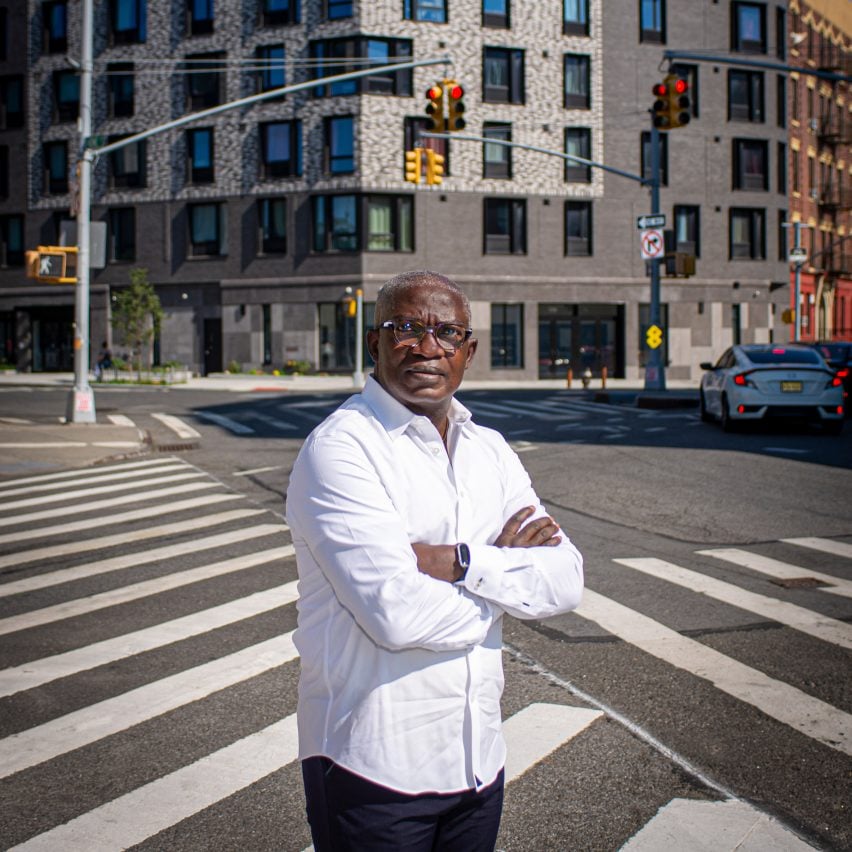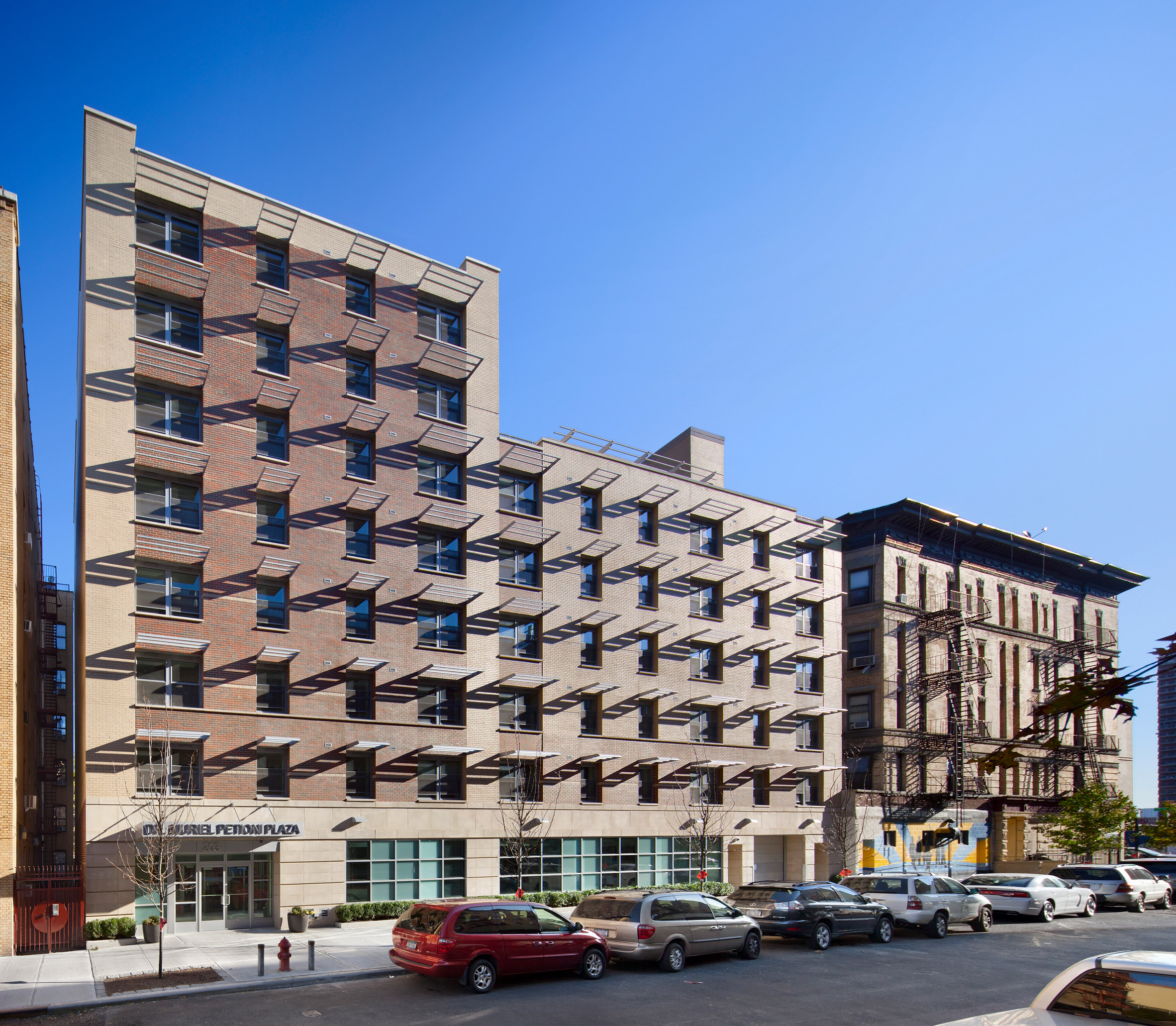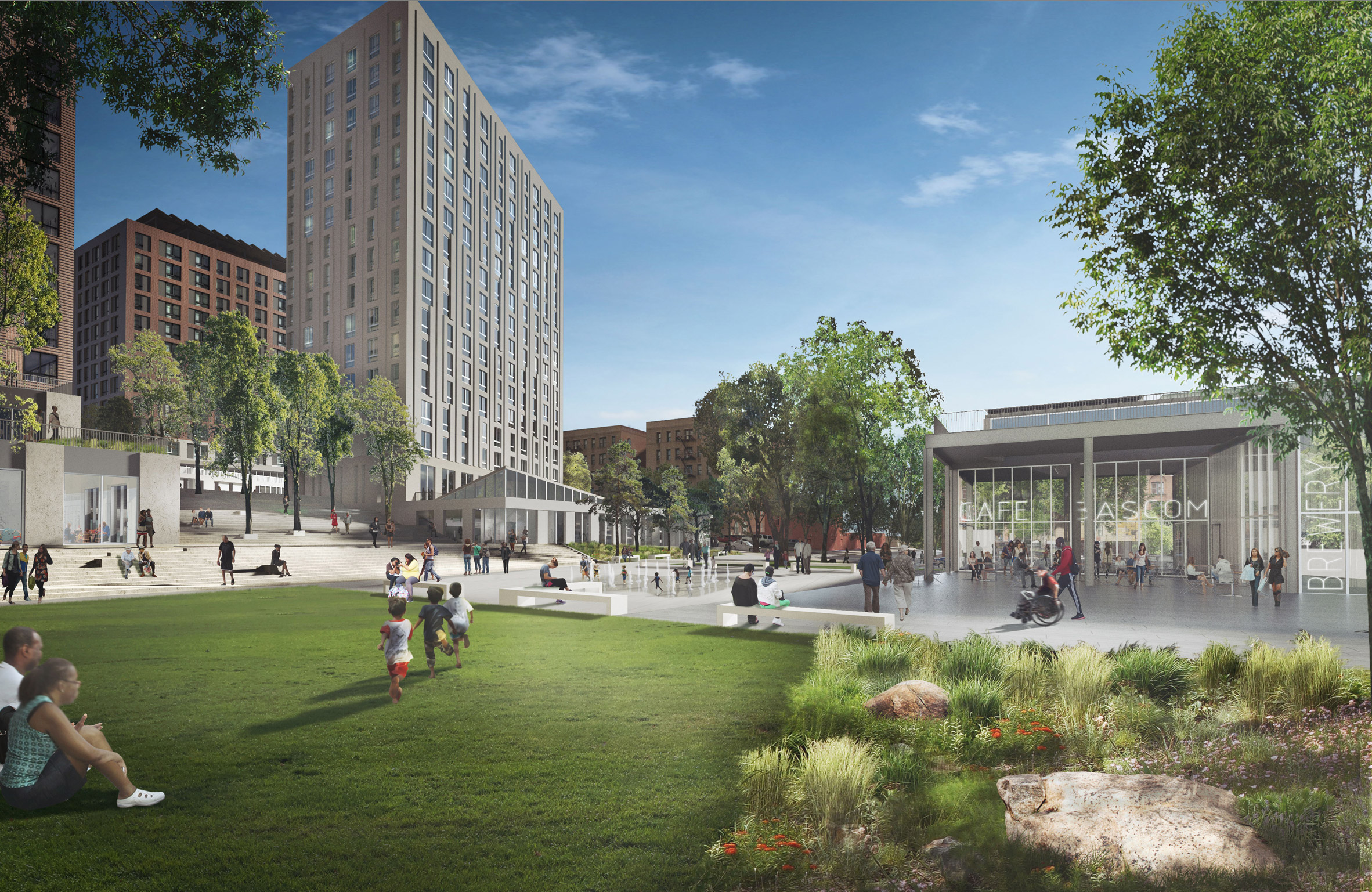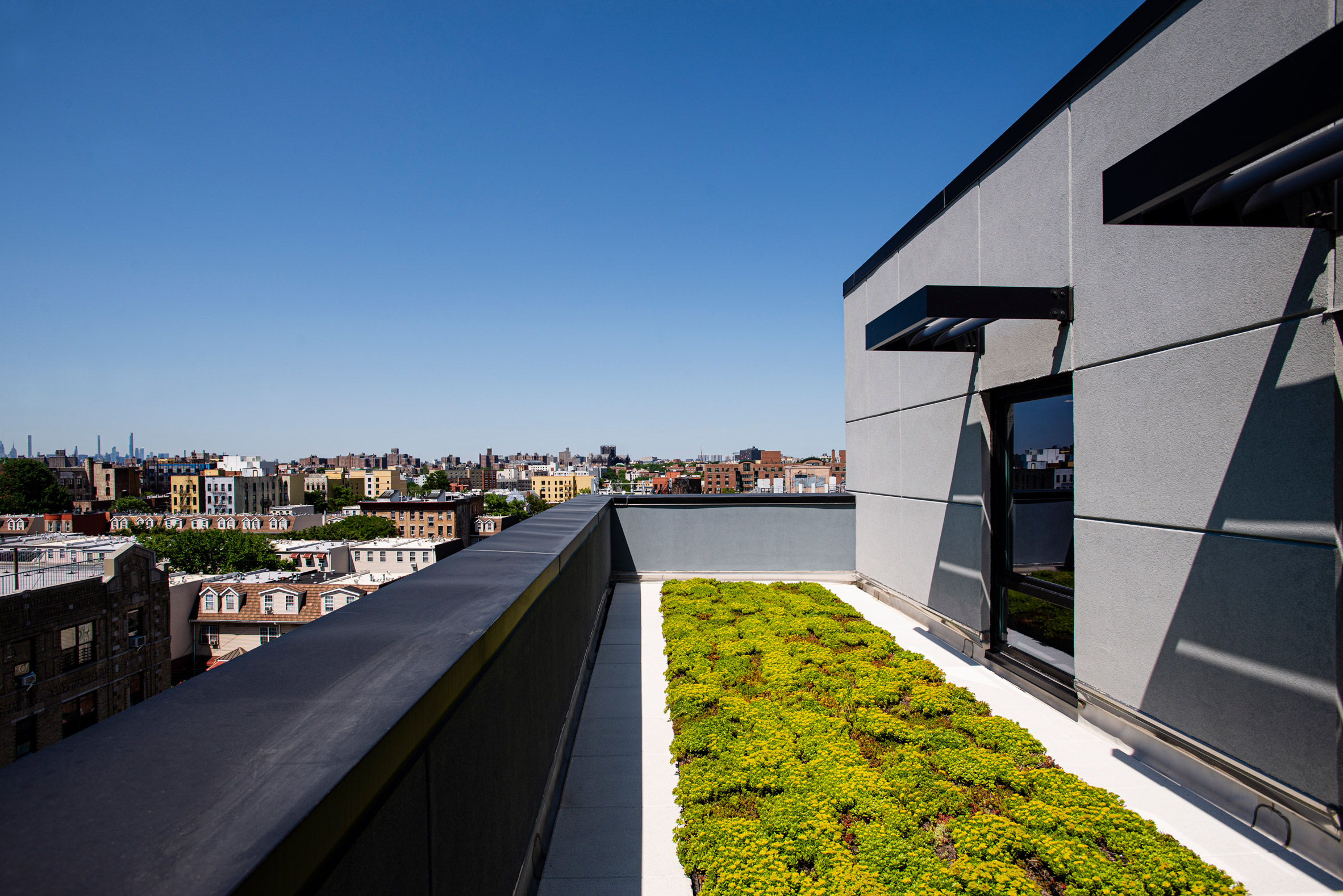
Architects should see themselves as the representatives of the community in the building process and not simply as an agent of developers, argues low-cost housing specialist Victor Body-Lawson in this interview.
Body-Lawson, whose diverse studio designs housing for low-income areas in the US and Africa, told Dezeen that architecture is about finding ways to open dialogue and bring people together.
“Over the years of practising, I have come to realize that the best tool for empowering people is through affordable housing,” he said.

The architect grew up in Nigeria and founded his self-named practice in 1993.
The studio, Body-Lawson Associates, has focused on affordable housing in the boroughs of New York, working with developers and the community to build structures that seek to serve people’s needs.
Its designs include Erbograph Apartments, a senior housing project that was the first LEED Silver building in Harlem, as well as Home Street Residences, an affordable housing complex in the Bronx.
“I feel that affordable housing just gives end-users, particularly people who are disenfranchised, people who don’t have social equity, the power to move from point A to point B in their lives,” Body-Lawson said.
“So that by the time they get to point B, they are much more socially, economically, culturally, and spiritually stronger.”
“Representation at the table was very, very important”
His methods for doing this focus on balancing the needs of communities with the prerogatives of developers.
“One of the interesting things about architecture is that it’s like a jigsaw puzzle,” he said. “And dialogue is absolutely important when it comes to putting the jigsaw puzzle together.”
According to Body-Lawson, having architects that come from the communities where building is happening is essential to really understand the needs of the people who live there.
In line with this, Body-Lawson’s studio is made up primarily of people from minority backgrounds in the US.
“When I first started it wasn’t 100 per cent that we had to have people from minority backgrounds,” he said. “But I noticed that the representation at the table was very, very important.”

“I always look at our studio as a place that brought different voices to architecture,” he continued. “I figured that people who came out of that environment had the nuances to deal with and build in those environments, and they would be sympathetic throughout the process.”
Besides just being at the service of developers, Body-Lawson believes that the architect has a greater role to play when it comes to addressing the needs of a community and advocating for the needs of the people in the design process.
“We look at ourselves, without being overtly apparent about it, as the representatives of people who eventually will live, work and play in our buildings,” he said. “When I work with colleagues I just want them to have that visceral connection to the place where they’re working.”
“Black Lives Matter was a game-changer for us as architects”
The sense of architects as community representatives is gaining momentum amid major global issues like the pandemic, climate change and racism, Body-Lawson argued.
“I think we’re in a very interesting time on the planet,” he said. “I think we as a people globally are being tested about our relationship to ourselves and also to the planet in everything that we do.”
“This moral shift, or this psychological shift, is causing everyone, from children to adults, to question that place in time,” he added, noting that Black Lives Matter’s effect on the architecture field was an “existential” one for him.
“I think Black Lives Matter was a game-changer for us as architects in that it forced institutions to look at social equity,” he said.

Body-Lawson gave the example of a recent request to redevelop an area of Brooklyn that has been historically redlined – the process by which majority-Black neighbourhoods were excluded from housing finance.
He said that the proposal appeared to be written by someone from the community and that it was the first time that he’d seen such a thing.
“The city had essentially gone out to the communities to reach out to get a sense of what [the community] felt,” he said.
“I think a lot of other cities are now starting to look at much more sympathetic ways of requesting for Neighborhood Development,” he continued.

“So I think yes, this Black Lives Matter movement is beneficial and I think, as an optimist, it will be good, but it’s still a very young culture,” he cautioned. “There are still people who have interests that are not congruent with the interests of people who are disenfranchised.”
“What I try to do is to make it so that anyone who lives in the building, whether they own it, or they’re renting it, they have a sense of place, a sense of ownership, a sense of control,” he said.
Read on for the full edited transcript of the interview with Body-Lawson.
Ben Dreith: How did you get into architecture and was there a defining moment that set you down your current path?
Victor Body-Lawson: My father was a surveyor in Nigeria, so I was born with drafting tools, taking measurements and all that. I grew up in that sort of environment. So when it was time to go to college, I knew how to draw.
In my first architecture class, the professor was talking about scales and rulers and measuring devices and T squares and machines for making blueprints. The other students had never heard of what he was talking about. And it was like, wow, this is what I was meant to do. So that was a defining moment. I’ve come to realize that I don’t like to do anything else. Let’s say, I was born into the field, into the built environment.
Ben Dreith: What are the main focuses of your studio?
Victor Body-Lawson: My focus has always been to empower the end-user of projects in any way that we can. And I know it’s a broad statement, but I think architecture is something that we inherit you know, culturally. We inherit it in time, we inherit it in space, but not all of us own our environments literally. We don’t have ownership or stewardship of our environments. What I try to do is to make it so that anyone who lives in the building, whether they own it, or they’re renting it, they have a sense of place, a sense of ownership, a sense of control.
So over the years of practising, I have come to realize that the best tool for empowering people is through affordable housing. So our studio is focused on affordable housing, particularly in urban areas. In the Bronx, Queens, New Jersey. I feel that affordable housing just gives end-users, particularly people who are disenfranchised, people who don’t have social equity, the power to move from point A to point B in their lives. So that by the time they get to point B, they are much more socially, economically, culturally, and spiritually stronger. We’ve tried to make that a byproduct of doing architecture.
We do a lot of work with churches as well, because, again, that’s the moral background of a lot of communities, in our cities, particularly in black communities. Churches have this voice that they can use to lead people and help people through whatever they’re going through. So between churches and affordable housing, we are doing work to create this dialogue that empowers and grows the people who live in and work and play in our buildings.
Ben Dreith: How do you manage the tension with developers and the need to continue to create things that are profitable for the city and for the investors as well as the community?
Victor Body-Lawson: You know, one of the interesting things about architecture is that it’s like a jigsaw puzzle, right? In this case with many, many stakeholders. And dialogue is absolutely important when it comes to putting the jigsaw puzzle together. So everyone has to feel like they get what they want and in our case, we believe that without getting everyone’s buy-in into the project, you really don’t get a good product, right. Again, sometimes the people who end up using these buildings and spaces don’t have a voice in that dialogue, right? They don’t have a voice in that conversation. So we look at ourselves, without being overtly apparent about it, as the representatives of people who eventually will live, work and play in our buildings. So we try to find a way to create a sense of balance throughout the work. So we encourage developers, we encourage the city, we encourage stakeholders, and we encourage communities to look at the end goal to look at what will benefit not only the community but also the people who manage those buildings.
I’ll give you an example. If you use a material that is durable and you show the end-user how to use that material, and how that material benefits them they’ll take care of it as if it was their own. And at the same time, it benefits the city because now you’re creating more stable environments where there’s a sense of brightness, a sense of place and a sense of ownership. That benefits the owners as well or the landlords or the developers because they don’t have to spend as much to secure the place, to maintain the place, and they have a better relationship with the people who live in the building.
So we try to, in our work, create the sense that it’s better to use materials and equipment that will give individuals an essence of ownership in spaces and then in environments, to essentially control it 100 per cent. Give each person their own thermostats so they can control their units to their desire. And that alone is, I think, an empowering system or device to create a sense of ownership.
Ben Dreith: And this feeds into your having a diverse team to manage this approach. Why else is that important to you?
Victor Body-Lawson: When I first started it wasn’t 100 per cent that we had to have people from minority backgrounds. But I noticed that the representation at the table was very, very important. And I wanted to make sure that our practice was set up like a studio for learning. For instance, people who would come would learn for a few years and then would move on. So we used that as the springboard or for teaching.
Besides the fact of being a teacher throughout my profession, I’ve always had one foot in academia and I always look at our studio as a place that brought different voices to architecture. I figured that people who came out of [underprivileged] environments had the nuances to deal with and build in those environments, and they would be sympathetic throughout the process in terms of talking to the developer or talking to the city, so you would have this sort of sense of empathy for the work that you were doing and for the end-user.
So that is one of the motivating factors that we’ve always used to make sure that where people work on the projects there are also people who come from those communities as opposed to bringing someone from another country or another state with no connection to that particular place. That is what I look for. When I work with colleagues I just want them to have that visceral connection to the place where they’re working. And then when those buildings get done, there is a greater sense of pride. “I was part of this and I was able to contribute to this community in my time.” And finally, we also market to local developers who, you know, who, again, are part of the community. To us, it’s a win-win.
Ben Dreith: Have you noticed any changes in the field since the George Floyd uprisings as someone who does so much work in the communities affected by the changes, or lack of changes?
Victor Body-Lawson: It’s an existential question stemming from where I am, right. I think we’re in a very interesting time on the planet. Or as I call it, a spaceship called Planet. You can’t divorce the George Floyd incidents or Black Lives Matter from Covid. I think we as a people globally are being tested about our relationship to ourselves and also to the planet in everything that we do. This moral shift or this psychological shift is causing everyone, from children to adults, to question that place in time. I think Black Lives Matter was a game-changer for us as architects in that it forced institutions to look at social equity. I think it’s sort of lasted a while and I think people continue to move forward. But Covid also is playing a strong role in how we see ourselves.
Let me give you an example. I recently saw a request for proposal that was sent out by New York City for a neighborhood in Brooklyn that had been redlined for many years, and the development proposal was written as if it came from someone who lives in that community.
The city had essentially gone out to the communities to reach out to get a sense of what they were going there and what [the community] felt. And this was one of the first times I’ve seen something like that. In the past, it was always written as developers building X number of units and extending, essentially. How can we increase our target space? How can we make sure the developer gets the best out of it? How can we build a sustainable project here, and how do we know 1,000 people want to live in these buildings? You know, it’s pretty much the basic NYC warehousing model, but this sea change by the city, and I think a lot of other cities are now starting to look at much more sympathetic ways of requesting for neighborhood development. This suggestion is to build empathy and to build sustainability through a much more sensitive way of building community.
So I think yes, this Black Lives Matter movement is beneficial and I think, as an optimist, it will be good, but it’s still a very young culture. There are still people who have interests that are not congruent with the interests of people who are disenfranchised. So until we come to a sense of how to help urban environments where people have been, you know, set it aside, it’ll take a while. That’s what I’m saying. But these agencies are much more concerned about the number of units that they can get as opposed to how the building functions for people who live in those buildings. So again, that’s something that we are always coming up against, and sometimes we fight and we try to educate the city or the agencies in terms of how to make sustainable projects and I’m not only talking about environmentally sustainable by I’m talking about socially, and morally sustainable projects and cultural as well.
The post "The best tool for empowering people is through affordable housing," says architect Victor Body-Lawson appeared first on Dezeen.
